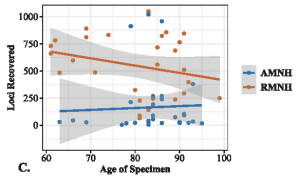
The use of gDNAs isolated from museum specimens for high throughput sequencing, especially targeted sequencing in the context of phylogenetics, is a common practice. Yet, little understanding has been focused on comparing the quality of DNA and results of sequencing museum DNAs. Dragonflies and damselflies are ubiquitous in freshwater ecosystems and are commonly collected and preserved insects in museum collections hence their use in this study. However, the history of odonate preservation across time and museums has resulted in wide variability in the success of viable DNA extraction, necessitating an assessment of their usefulness in genetic studies. Using Anchored Hybrid Enrichment probes, we sequenced DNA from samples at 2 museums, 48 from the American Museum of Natural History (AMNH) in NYC, USA and 46 from the Naturalis Biodiversity Center (RMNH) in Leiden, Netherlands ranging from global collection localities and across a 120-year time span. We recovered at least 4 loci out of an >1,000 locus probe set for all samples, with the average capture being ~385 loci (539 loci on average when a clade of ambiguous taxa omitted). Neither specimen age nor size was a good predictor of locus capture, but recapture rates differed significantly between museums. Samples from the AMNH had lower overall locus capture than the RMNH, perhaps due to differences in specimen storage over time.
Goodman, A., Tolman, E., Uche-Dike, R., Abbott, J., Breinholt, J. W., Bybee, S., . . . Yoshizawa, K. (2023). Assessment of targeted enrichment locus capture across time and museums using odonate specimens. Insect Systematics and Diversity, 7(3). doi:10.1093/isd/ixad011